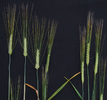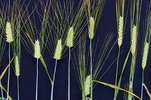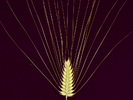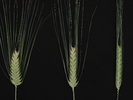International Database for Barley Genes and Barley Genetic Stocks
BGS 42, Pyramidatum 1, Pyr1
Stock number: BGS 42
Locus name: Pyramidatum 1
Locus symbol: Pyr1
Previous nomenclature and gene symbolization:
Pyramidatum g = Pyr.g (5).
Pyramidatum i = pyr.i (5).
Pyramidatum i = pyr.i (5).
Inheritance:
Monofactorial recessive (2), which enhances the effects of Zeo2 (Zeocriton 2) (2, 3).
Located in chromosome 3HL (2); Pyr1.g is associated with SNP markers 2_0410 to 1_0926 (positions 61.77 to 85.26 cM) in 3H bin 05 of the Bowman backcross-derived line BW660 and with a marker in 2HL bin 13 where Zeo2 (Zeocriton 2) locus is located; Pyr1.i (previously Pyr2.i) is associated with SNP markers 1_0825 to 2_0704 (positions 61.77 to 100.48 cM) in 3H bins 05 to 06 of the Bowman backcross-derived line BW661 and with markers in 2HL bin 13 where Zeo2 (Zeocriton 2) locus is located; pyr1.aw (previously pyr.aw) is associated with SNP markers 2_0890 to 2_0704 (positions 82.03 to 100.48 cM) in 3H bins 05 to 06 of the Bowman backcross-derived line BW662 (2), in 3H bin 05.
Located in chromosome 3HL (2); Pyr1.g is associated with SNP markers 2_0410 to 1_0926 (positions 61.77 to 85.26 cM) in 3H bin 05 of the Bowman backcross-derived line BW660 and with a marker in 2HL bin 13 where Zeo2 (Zeocriton 2) locus is located; Pyr1.i (previously Pyr2.i) is associated with SNP markers 1_0825 to 2_0704 (positions 61.77 to 100.48 cM) in 3H bins 05 to 06 of the Bowman backcross-derived line BW661 and with markers in 2HL bin 13 where Zeo2 (Zeocriton 2) locus is located; pyr1.aw (previously pyr.aw) is associated with SNP markers 2_0890 to 2_0704 (positions 82.03 to 100.48 cM) in 3H bins 05 to 06 of the Bowman backcross-derived line BW662 (2), in 3H bin 05.
Description:
Hayes and Harlan (6) reported that one gene controlled spike density in the line Pyramidatum. Spike shape, parallel vs. truncate pyramidal, is considered of limited value as a key character, but it is used in description of barley cultivars (1). Spikes are about 2/3 of normal length and have rachis internode length values of about 2.5 mm. Plants homozygous for Pyr1.g have pyramid-shaped spikes because lower rachis internodes shorter than upper ones. Spikes of heterozygous plants are parallel or strap-shaped. Plants homozygous for Pyr1.a are slightly shorter and have stiffer straw (3). When combined with Zeo2 (Zeocriton 2), spikes of Pyr1 plants are about 2/3 of normal length and have rachis internode length values of about 2.3 mm. The plants have pyramid-shaped spikes because lower rachis internodes are shorter than upper ones. The Bowman backcross-derived lines BW660 and BW661 have this phenotype. BW662, also derived from Pokko, has a similar 3H segment retained, but rachis internodes are only slightly shorter than those of Bowman, 3.6 vs. 4.5 mm (3). Unlike BW660 and BW661, BW662 does not have SNP marker 2_0590 (position 218.47 cM) in 2H bin 13 (2). The semi-compact spike trait of BW662 was associated with a recessive inheritance pattern in backcross-derived progenies. Culms and peduncles of plants in lines BW660 and BW661 were 10 to 20% shorter than Bowman while a height reduction was not observed in BW662 (3). Kernel shapes and weights and grain yields of the BW lines for Pyr1 were similar to those of Bowman (3).










Origin of mutant:
Probably natural occurrence in Finnish cultivars (3), but isolated from a backcross of Pokko (PI 467770) to Hja80001 (GSHO 1689, DWS1246), which is a gamma-ray induced, brachytic mutant from Aapo (PI 467771) (7).
Mutational events:
Pyr1.g in Hja64202 (Pokko*3/Hja80001 mutant, DWS1242, GSHO 1581) (4, 7).
Mutant used for description and seed stocks:
Pyr1.g (GSHO 1581) in Hja64202; Pyr1.g in Bowman (PI 483237)*7 (GSHO 2149, BW660, NGB 22225); Pyr1.i from Pokko mutant Hja79010 (Pokko*3/Hja80001 mutant, GSHO 1582) (7) in Bowman*6 (GSHO 1941), in Bowman*7 (BW661, NGB 22226); pyr1.aw from Hja80089 (7) in Bowman*7 (GSHO 2040, BW662, NGB 22227).
References:
1. Åberg, E., and G.A. Wiebe. 1946. Classification of barley varieties grown in the United States and Canada in 1945. U. S. Dept. Agr., Tech. Bull. 907. 190 pp., illus.
2. Druka, A., J. Franckowiak, U. Lundqvist, N. Bonar, J. Alexander, K. Houston, S. Radovic, F. Shahinnia, V. Vendramin, M. Morgante, N. Stein, and R. Waugh. 2011. Genetic dissection of barley morphology and development. Plant Physiol. 155:617-627.
3. Franckowiak, J.D. (Unpublished).
4. Franckowiak, J.D. 1999. Coordinator’s report: Semidwarf genes. Barley Genet. Newsl. 29:74-79.
5. Franckowiak, J.D., and A. Pecio. 1992. Coordinator’s report: Semidwarf genes. A listing of genetic stocks. Barley Genet. Newsl. 21:116-127.
6. Hayes, H.K., and H.V. Harlan. 1920. The inheritance of the length of internode in the rachis of the barley spike. U.S. Dept. Agr., Bull. 869. 26 pp.
7. Kivi, E.I. 1986. (Personal communications).
2. Druka, A., J. Franckowiak, U. Lundqvist, N. Bonar, J. Alexander, K. Houston, S. Radovic, F. Shahinnia, V. Vendramin, M. Morgante, N. Stein, and R. Waugh. 2011. Genetic dissection of barley morphology and development. Plant Physiol. 155:617-627.
3. Franckowiak, J.D. (Unpublished).
4. Franckowiak, J.D. 1999. Coordinator’s report: Semidwarf genes. Barley Genet. Newsl. 29:74-79.
5. Franckowiak, J.D., and A. Pecio. 1992. Coordinator’s report: Semidwarf genes. A listing of genetic stocks. Barley Genet. Newsl. 21:116-127.
6. Hayes, H.K., and H.V. Harlan. 1920. The inheritance of the length of internode in the rachis of the barley spike. U.S. Dept. Agr., Bull. 869. 26 pp.
7. Kivi, E.I. 1986. (Personal communications).
Prepared:
J.D. Franckowiak. 2002. Barley Genet. Newsl. 32:82.
Revised:
J.D. Franckowiak. 2011. Barley Genet. Newsl. 41:78-79.
